Burning Issues
Ecotrail Travelogue Contest- A follow –up
-Susan Sharma
WWF(India) along with Lonely Planet Magazine (India) organized a travelogue contest in 2010. The contest was open to travelogues written about the Himalayan region. The writings brought out what ails our mountain ecosystems which are also some of the most
popular tourist destinations.
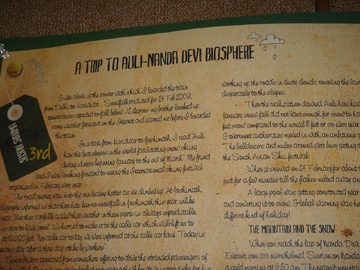
Here is a page from the WWF(I) write-up on the winners of the ECOTRAIL TRAVELOGUE CONTEST (http://wwfindia.org)
Quote:
1st
She writes “My Himalayan journey has sharply exposed the fragility of both the local people and the traveller when nature’s balance is disrupted.”
The first prize of the Ecotrail contest went to Ms. Katherine Joanna Johnson from UK. An architect, she is currently pursuing her Masters in Architecture from the London Metropolitan University. When the cloudburst struck Ladakh in August 2010, she happened
to be there and almost lost her life while trying to get back to safe ground. Her journey taught her not only to value life more but also a lot about the environmental damage that has already been caused to this fragile region. She stayed back and provided
her architectural knowledge to the SEEDS India team to design buildings that are sustainable and less vulnerable to disasters. She has been working with bamboo and mud, as sustainable construction material in the Almora region.
2nd
“As I lingered after my stay, reluctant to leave, my host had a twinkle in his eye. There’s a compulsory rule to this homestay, he said: Every satisfied guest has to plant a tree before leaving! Joyfully muddying my hands planting an oak-sapling, I wondered
why more resort owners hadn’t thought of this remarkable conservation idea!”
The second prize went to Ms. Indu Balachandran, a travel and humour columnist based in Chennai. Travel is her greatest passion, and she reviews eco-friendly hotels all over India for an Indo-Danish website, ‘traveltocare.com’. The awesome majesty of the Himalayas
elevates her entire spirit and she is of the opinion that no travel experience in the world beats that feeling!
3rd
“…snow white peaks suddenly rising out of horizon turned our thrill into sheer joy. But soon a disgusting vista jolted us out of our blissful state of mind. There were tunnels blasted in the hills… Dozens of trucks roared about and the effect of soot could
be felt in the air.”
The third prize went to Mr. Sohail Jafferi, an indeprendent documentary filmmaker based in Mumbai. He went along with his cinematographer friend to Kinnaur to capture its natural splendor of which he had heard so much. What he saw there surpassed his expectations.
The mega hydel projects in the regions have disturbed him greatly, so much so that an ambitious documentary on this issue is under production right now!
The third prize also went to Susan Sharma, who writes “As we moved down I collected a few branches of golden oak leaves. The trees marked with the "death warrants" continue to haunt me when I look at these leaves dried but golden, weeping silently in my vase.”
When she is not up there climbing mountains, she works as an Information System specialist in Gurgaon. She runs an online nature club called ‘IndianWildlifeClub.com’, leading people to the cause of nature conservation. The Himalayas to her is nature at its
most majestic and most vulnerable.
Unquote

The Auli travelogue which won the third prize (tie) can be read in full at the link
http://travelphotolog.blogspot.com/2009/03/visiting-ski-slopes-of-auli.html
The Blog was written based on my visit to Auli in February 2009.
I also did a search on the Internet to find out the current position of the Auli ski slopes. Here are some of the writings I found.
Artificial lake-
(From tourist sites)
The world's highest man-made lake is at Auli, right next to the private hotel, Clifftop Club. The government has developed this in view of creating artificial snow on the new ski slopes in the event of low snow fall. The water from this lake will be used to
feed the snow guns stationed along the ski slopes and thus provide a good skiing surface and exend the ski season.
(http://ezinearticles.com/?Adventure-Skiing-Sports-in-Auli&id=5481444)
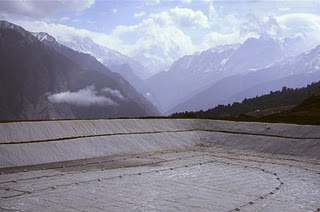
Visit by a politician
"I was happy to see that the State Government had taken a stand on implementing "the rule of law", howsoever much strength the law-breaker may wield. A large number of poor locals, who happily offered their land for a good cause - extension of ski-resort -
also came with folded hands for payment of compensation for their land. Government officials promised prompt payment. I am happy that the State Government is reported to have already deposited Rs 6 Crores with the authorities responsible for payment of compensation.
Villagers argued that, on the one hand, the poor man's land was being acquired and, on the other hand, the rich hotelier was being allowed to encroach upon government land. To escape such embarrassments, I requested the sports minister to prepare a long term
plan and bisect the entire Auli formation into residential and ski zones. The minister appreciated the suggestion and I hope for the best as soon as possible."
(http://www.garhwalpost.com/article/Feature/9003/)
An investigative journalist
"To lay an international standard ski-slope an Austrian expert was hired and the contract for constructing the slope was given to a Kashmir company called Space Age. The company removed the high-altitude grass that grew on the slope, exposing the layer of soil
underneath. Such high Alpine slopes (Auli is at 10,000 feet) are considered highly environ-mentally sensitive and it is forbidden to interfere with them in Europe and other countries as well. Here if one digs and removes even a little bit of grass cover, that
wound starts spreading and it becomes very difficult to contain the erosion.
However, after the grass cover was removed and the soil layer underneath exposed in the summer of 2008, rains started and began washing the soil below in torrents right down to villages and Joshimath town, 15 kilometres below. Water and soil filled homes of
the Joshimath town people and the municipality had to employ workers to clean it from rooms.
With soil washed down, the ski-slope was left with ditches and rifts, some 10 feet deep.
For creating a lake to make artificial snow, water was brought through pipes from some 10 kilometres up the mountain. The contract for putting up a snow-making machine and laying pipes along the slope was given to an Italian company called Snow Star. Last winter
the machine was tested to see if it made snow and managed to spread it along the slope. It was supposed to do so when the temperature in Auli was two degrees above zero. The Auli temperature at that time was lower than that. But the machine failed to make
snow. Its pipes spewed some white stuff up in the air but there was no snow on the ground, only water!"
(http://www.mainstreamweekly.net/article2324.html)
Are we going to do something to stop wanton destruction of our mountainscapes?
|
Did You Know ?
Colour coding in evolution
Genetic bases for siblings to ensure they are not treated alike has fallen to research, says S.Ananthanarayanan.
Species sometimes go lengths to look like another, so that they deceive predators. Duke University graduate student Robin Hopkins was working with the contrary feature -instances of the same plant species making arrangement to look different, so that butterflies
think they are not the same plant and they breed separately. Robin Hopkins has only just finished defending her doctoral thesis and her paper, written with Duke University professor Mark Rausher, has appeared in the journal, Nature.
Looking alike
When some individuals of a species happen to resemble similar looking species, which is distasteful to or feared by predators, these ‘imposter’ individuals borrow protection and enjoy a survival advantage. The genetic feature which causes this resemblance is
then selected and stabilises. This form of mimicry, which is called Batesian mimicry, after its discoverer, Henry Walter Bates, is seen in several butterflies and reptiles and is the most common form. Another form of mimicry is Müllerian mimicry where species
which have their own individual means of protection, still converge, although partly, for mutual benefit. Yet another form is where a harmful species disguises itself as a harmless one, both to avoid conflict as well as to sneak up on unsuspecting prey. These
are all instances of different species trying to look alike, the converse of what Robin Hopkins’ work, which is on individuals of the same species trying to look different from their brothers and sisters, so that they can breed and hence evolve along a different
direction, to grow as a different species.
Speciation
Growth of new species from a parent species is nature’s method of adapting to changing environment and distributing the demands on the environment, so that the species could be sustained. Every act of reproduction usually creates some genetic chance peculiarity.
But in the large majority of instances, the distinction is of no consequence and it gets lost in interbreeding. Occasionally, the difference is of material advantage to survival or procreation and then the difference would persist and continue, through natural
selection. Such growth of new species adds to biodiversity and ensures the dynamic balance that maintains vast networks of species even as natural conditions vary and change.
But there are conditions to be satisfied if a new species is actually to arise. A case where only the individuals with the new feature survive is really not the addition of a new species. But if both kinds continue, there would need to be some separation, so
that both kinds do not interbreed and the genetic streams diverge. For instance, one kind may forage on a different nutrient or may be physically separated. Sometimes, the parts of a species that is divided by a barrier, like a mountain range or a stretch
of water, go on to evolve into separate species, because of the physical ‘gene isolation’.
There has been ample work on the genetic bases of such speciation, which arises from physical restraint of gene flow. But hardly any work has been done on the mechanism, called reinforcement, of natural selection directly preventing crossbreeding of the two
strains of the species in the same habitat. As the 2 strains have arisen for some survival benefit, lack of reinforcement would lead to the distinction being lost or the creation of unviable hybrids, both of which are a cost to the community.
In animals and insects, the mutant stream may display small but perceptible differences in odour, colours or behaviour, which could regulate mating and gene exchange. But this mechanism cannot work in the case of plants, which reproduce through pollination
by external agencies.
The ornamental phlox
The Annual Phlox, a decorative flowering plant native of Texas but now cultivated in many places, exists as 2 streams, phlox drummondii and phlox cuspidate. When grown separately, both varieties thrive with flowers of a light periwinkle blue. But if grown together,
and there is cross breeding, the offspring have flowers of intermediate colour, but in nearly in all the cases, the plants are sterile. The generation that arises from cross breeding is thus a dead end!

Phlox drummondii, when grown with cuspidate, then adopts an ingenious device to avoid pollination, and gene transfer, across species – it develops flowers that are red in colour! As individual butterflies that visit these flowers appear to have a preference,
either for blue or red flowers, cross pollination actually occurs only between similar coloured flowers and the strains stay separate. As hybrids are usually sterile, there is powerful natural selection to maintain the colour difference in p. drummondii, when
it breeds along with p. cuspidate.
This remarkable mechanism of ‘colour coded polination’ has been known for some time, but the genetic basis for the difference in colours of flowers was not understood. In the course of collecting data in her work, Hopkins noticed that the intermediate colours
of hybrid flowers were distributed according to a clear pattern, which corresponded to the ratios discovered some 150 years ago by Gregor Mendel, in his experiments with pea plants.

Hopkins carried out greenhouse experiments by interbreeding the 2 varieties of phlox and found that the hybrids formed with flowers of 4 specific intermediate colours – dark blue, light blue, dark red and light red – exactly in the ratio of 9:3:3:1.
This is the established ratio when a feature is controlled by a pair of genes, with one being dominant and the other recessive. The dominant gene then appears in 3 out of 4 cases, while the recessive one appears in 1 case. Thus in crossbreeding, genes in the
offspring would be distributed as: 3x3=9, 3x1=3, 1x3=3 and 1x1=1.
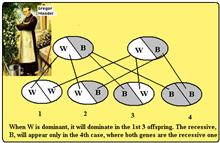
With this clue of what to look for, standard genetic methods could lead to the exact genes that were responsible – the change to red is caused by 2 genes, one recessive and the other dominant, which knock out the production of the plants one blue pigment, but
allow the 2 red pigments to continue. The result is an important advance in the mechanism of evolution and maintenance of biodiversity.
"It was 2 in the morning when I figured this out," she said. "I almost woke up my adviser," says Hopkins.
[the writer can be contacted at simplescience@gmail.com]
|
Endangered
-Vinod Rishi
Here is the third part of an article published by Shri Vinod Rishi in
The Indian Forester. Vol.136:10. Wild Life Special.
Shri Vinod Rishi is IFS – retd. and a Former Additional Director General of Forests
(Wildlife), Govt. of India; E-mail: vinodrishi@rediffemail.com
State Level Monitoring
Table1
Estimated Tiger Populations In Some States*
|
STATES
|
MIN
|
MID-VALUE
|
MAX
|
|
BIHAR
|
7
|
10
|
13
|
|
CHHATISGARH
|
23
|
26
|
28
|
|
ORISSA
|
37
|
45
|
53
|
|
RAJASTHAN
|
30
|
32
|
35
|
|
KERALA
|
39
|
46
|
53
|
|
ARUNACHAL
|
12
|
14
|
18
|
|
MIZORAM
|
4
|
6
|
8
|
|
N. WEST BENGAL
|
8
|
10
|
12
|
*Source: Status of Tigers, Co-predators & Prey in India. NTCA.
At the State level, too, the results do not help in meaningful understanding of tiger
populations:
A. The range of values in small populations is too wide to given any meaning to the
record of the status of tigers in the State.
B. The statistical range of values has created a smoke-screen over the tiger
conservation efforts. For instance, the estimated range of tiger population in Arunachal
Pradesh is shown as 12 to 18 tigers with a mid value 14 (Table). So long as the local
information places the figure for tigers anywhere within the range – arrived at by a more
trusted scientific exercise by an authority no less than NTCA – there is no cause for any
alarm even if poachers take a few tigers, as long as their presence or activity is not
detected. The advantage goes to the poachers.
C. The Information Generated by the Approach The foundation stone of conservation of tiger in India starts with the knowledge about some basic aspects. When we examine the results of the NTCA’s Holistic Approach for providing this knowledge, it is evident that
even 5 years after the collection of field data the exercise has failed to provide the crucial information it was supposed to have given:
a) How Many Tigers? Not precisely known at national or state levels!
b) Population Trends? Cannot be known; structure of the populations is not known!
c) Areas where decreasing & why? Cannot be known; tiger occupancy maps and records are defective!
d) Status of tiger’s wild prey? Not yet available.
e) State of tiger habitat? Not yet available.
f) Spacing & connectivity of Wildlife Populations? Not yet available.
It raises a question: for whose benefit the current approach was adopted – tiger
conservation or academic advancement?
-To be Continued
|
Events
Biodiversity Conservation
A one-day seminar on Biodiversity Conservation is Planned in Mumbai on Feb 12.
There would be invited talks and panel discussions by experts.
Vijnan Bharati, Mumbai
Introduction The human race has befitted immensely from the wide diversity of life forms on earth. The current excessive utilization of this biodiversity, however, has raised strong doubts about its sustenance and hence Biodiversity Conservation has become
the prime need of the hour. The society can become conscious of this urgent need only through an understanding of its scientific, technological and social facets. The educated class has greater responsibility in this respect, including a thoughtful promotion
of necessary action at all levels. In appreciation of this need, Vijnan Bharati, Mumbai, proposes to hold a one-day seminar on ‘Biodiversity Conservation’ at Mumbai on February 12, 2010, in association with Deccan Education Society’s Kirti College, Mumbai
under the technical guidance and support of well known experts like Dr. Madhav Gadgil , Dr. Shyam Asolekar and Dr. Sharad Chaphekar.
The seminar is being organized with a view to bring the expert knowledge on the subject within the reach of the common man so as to create an informed and balanced awareness in the society on Biodiversity Conservation and start a fruitful interaction. Programme
The programme would consist of sessions having invited talks by experts so as to bring out different aspects of the seminar theme, a group discussion by specialists focusing on the biodiversity around Mumbai and a panel discussion cum open session on ‘Role
of NGO’s and individuals in Biodiversity Conservation Efforts’ followed by the creation of a Biodiversity Forum.
The audience would consist of a spectrum of persons, having background or interest in related topics, including researchers, teachers, engineers, professionals, students and common citizens. The delegates are likely to have an opportunity of listening to speeches
by experts like Justice Dharmadhikari, Dr. Asad Rahmani, Dr. Sanjay Deshmukh, Dr. Ambika Joshi & Dr. Sharad Chaphekar, apart from some informative discussions by some distinguished expert panel members.
It is proposed to use this occasion to display a set of posters on topics related to the theme of the seminar, to be prepared by groups of degree students of selected colleges so as to encourage their understanding of the subject through creative abilities.
The exhibition will be open throughout the seminar day for the benefit of the delegates.
Venue The Seminar would be held at D. E. Society’s auditorium in Kirti College campus; from 9:30 a.m. to 5:30 p.m.
Registration would start at 9.00 a.m. College & School teachers / Vijnan Bharati members The fees are to be paid in advance along with duly filled and signed registration forms, in cash / local cheques / D.D. (outstation), to be drawn in favor of ‘Vijnan Bharati
’. In case of bank money transfer, call the contacts below for account details.
All registered delegates would be provided seminar facilities, registration material as well as tea, refreshments & working lunch. Tel : 9820260491 e-mail : bdbhave@yahoo.com Dr. Durgadas Bagul, Secretary, Vijnan Bharati, Tel : 9819253970 e-mail : baguldg@gmail.com
Dr. Madhav Gadgil, Dr. Shyam Asolekar, Dr. Sharad Chaphekar, Shri Ravindra Pawar, Advocate Sandip Thakur. , Shri Jayant Sahasrabuddhe. Organizing Committee : Dr. Suhas Pednekar (Chairrnan), Shri G.K.Bhide, Dr. Hemant Pednekar, Dr. D.G. Bagul, Dr. Madhav Rajwade,
Dr. Govind Paratkar, Dr. Vidyadhar Walavalkar, Seminar Committee : Dr. Bhalchandra Bhawe ( Convener), Shri Subhash Bhagwat , Dr. Jayant Joshi, Shri Vasant Deokar, Dr. Chitra Joshi, Ms. Supriya Kale, Dr. Nandini Deshmukh, Dr. Chetan Ponkshe, Dr. Sankaran, Dr.
Vibha Mehra, Dr. Nandini Bondale.
*Trail to Tungareshwar Wildlife Sanctuary*
As one travels further north through SGNP, crossing over to the mainland,
you will reach Tungareshwar Wildlife Sanctuary, a little gem of a place with
a high birding potential. Being on the mainland there is a perceptible
change in topography of this semi evergreen forest.
Huge boulders wash down by countless streams and gigantic trees dot this
rough landscape.
Tungareshwar WLS is very well known for erratic sightings. A Crested Serpent
Eagle may be calling out in earnest for his mate, while a low bare tree may
give temporary shelter to a Shikra. One can see Magpie Robins, Eurasian
Golden Oriole, Chestnut Shouldered Pertronias, Golden fronted Chloropsis,
Racket tailed drongo and so on . Join us on a trail to Tungareshwar and
explore for its hidden gems, you never know what may cross your path.
*PROGRAMME SCHEDULE & Details*
*Date*: *Saturday*, 5th February 2011
*Place:* Tungareshwar Wildlife Sanctuary, Mumbai.
*Resource Person:* Mr. Saurabh Sawant
Naturalist and Wildlife Photographer
*Co-ordinator :* Ms. Neeta Jadhav
Timing: 07.00am to 11.00am
*Meeting Time:*
06.50am at Vasai Station (East) near ticket counter.
*OR*
07.30am at Tungareshwar Wildlife Sanctuary Base (near Sitaram Baba Ashram).
*How to Reach:*
Railway:
Rickshaw on sharing bases are available just outside the Vasai- east station
which will drop you to the base of Tungareshwar WLS. The rickshaws charge
Rs.20 to Rs. 25 per person. It takes almost half and hour to reach
Tungareshwar WLS Base from Vasai station by rickshaw.
Road:
Vasai Phata is approximately 20 kms. from Dahisar check Naka on the Mumbai-
Ahmedabad High way. Take a right from Vasai Phata which will lead to the
main gate of the sanctuary.
Reach Tungareshwar WLS Base : 07.30am
*Charges:* NONE
Group Size: 20
Queries & Registration Contact: Neeta Jadhav +91 9167344388
DELHIBIRD ANNUAL BIG BIRD DAY, SUNDAY 13TH FEBRUARY
"Its that time of year again when we fill the gas in our cars, put on our
best walking shoes, load up on books and binoculars and scopes and dash all
around Delhi and neighbouring sites madly ticking off birds on our list!
It is the day when we try and infect all newcomers with our enthusiasm and
celebrate the fact that despite all its faults, our city still plays host to
numerous species of birds and we make an effort to spread awareness and
ensure it remains that way. This is the big event, the marathon of birding
so get set and sign up for it.
In the evening we meet for a contributory dinner
A few teams below and need more volunteers to start new teams from new
places and to join the ones below
Bhindawas: Suresh Sharma, Koshy, Jagat and Rahul Jain
Dadri: Anand Arya
Basai: Sheila, Chandrima
JNU, Sanjay Van, Hauz Khas Lake, Aravalis: SP
Sultanpur: Ravi Chand, Namita, Medha, Nilanjana
Jaipur: Manoj Kulshretra, Gaurav Bhatnagar, Mayank Bhatnagar
Sonepat: Suresh Sharma, Gaggu
Chandigarh - Narbir
Team WWF - Ravi Singh, Mita
Ranthambhore Tiger Reserve - Aditya Singh, Salim Ali
As always we have Bikram Grewal computing the final lists, so all lists in the
evening to go to him.
WILDLIFE TRAINING COURSE
Wild Tuskers Society announces a 5 day “WILDLIFE TRAINING COURSE” starting on 24th Feb - 2011 for the wildlife enthusiasts who want to gain knowledge about wildlife and work for it. WTS will provide a certificate to the participants. This course will give a
comprehensive practical knowledge about wildlife which will help participants immensely in ‘Wildlife conservation and protection’
The content of the 5 days course will give you complete knowledge of Wildlife including their behavior, animal classification, identifying bird and reptiles, wildlife photgraphy and lots more.
Kindly mail at wildtuskers@gmail.com or call at 09012226130 for more details
|
Gardening for wildlife
-Contd from last month
The Butterfly Diaries
One doesn't quite expect to find butterflies in the desert but they were present alright. The common danaids were present since their food plant the Aak or Calotropis was present in my garden. Every day I saw tiny blues which I discovered to be the Dark Grass
Blue. There was also a Pioneer which stayed awhile and moved on. Insect life must exist in greater variety than one expects in small pockets in the desert as I also saw a wasp meticulously scour the garden presumably for caterpillars.
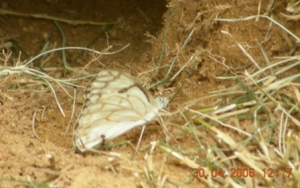
"The visiting Pioneer
The star of the garden is, of course, the jird. Most people call him 'gerbille' or 'kangaroo mouse'; he is neither. His short, rounded ears, chubby body, long thinly haired tail with dark tassel, and shorter legs than one would expect of a mouse looking like
a miniature kangaroo, he is the cutest of desert creatures in my garden.
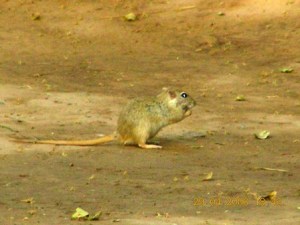
Meet the jird!"
One day he turned up in my newly developed garden strolling in as if he owned the place. This was followed by a detailed reconnaissance on his part which culminated with the selection of a spot by the gate where there was adequate shade available. He then
proceeded to dig as swiftly, continuously and urgently as he could, realising the risk he faced of being without a bolt-hole. Every few minutes or so, whenever he felt unsafe or uneasy, he would pause and sit upright, facing this way and later that, till he
was certain danger had passed. Then he would resume with renewed vigour. Sometimes his head was not seen as it was buried deep but the rear part of his body and his feet were rapidly jerking upwards above the ground level ejecting a constant stream of sand
from the hole. Finally, the burrow was done but it was becoming dark.
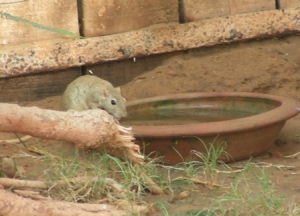
"Slaking its thirst before bossing us around
Tired but satisfied, he went to have a sip in the newly installed water-bowl but instead sat up at the edge and shrieked angrily. Peering to see what was the problem, I espied Mr and Mrs Todarmal stolidly sitting in the water. Only after I had driven off the
indignant toads and changed the water, and also hidden myself in the verandah, would the jird take his sip of water.
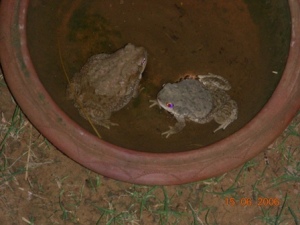
"The Toadar Mals
Now, master of all he surveys, he shows himself during the day only when it is not too hot. Then he emerges from his burrow, does his personal grooming and then clambers up the side of the bowl to drink his water. Thirst satisfied, he seeks to satisfy his
palate. This he does by raiding the bird-seed spilled over the edge of the feeder tray or by nibbling pieces of grass sitting outside his burrow. Should another jird enter the garden, there is a thorough free-for-all until he has vanquished the interloper.
One day I saw another slightly smaller jird and realised he had a mate. But alas, I was not fortunate enough to see their progeny as the authorities cottoned onto the fact that I was enjoying myself thoroughly and decided to remedy the fact by posting me to
the North East.

"The honeymooners
Though I am no longer physically present in the desert, in my mind's eye I can still return to enjoy those pleasurable moments that were once my good fortune to experience.
-The End
|
Green Defenders
Report of a participant
Report of a participant at an international course on conservation biology and wildlife
management sponsored and conducted by the Satpuda foundation, Nature Conservation Society Amravati and S.G.B. Amravati University with the support and collaboration of wildlife department of state of Maharashtra, India.
-Prajakta N Rain
Participants were selected with scientific background and field experience from
govermental-nongovermental wildlife organization & institutes. They all had a passion for
wildlife conversation, though they came from different habitats and different working
backgrounds.

Rakesh Kalva from Hydrabad is CA, Avantica Bijwe computer Science, Vishal Bansod
Architect, Radhika Kothari Snow Leopard Conservansy Ladakh, (did her education in mass
communication), Dr. Himani Kala FES Udaypur, Suresh Jones Banglore, Ramesh M, Eswar. S from NSTR, Shrisailam, Raghunathan FES Udaypur, Raj Koirala forest institute Pokhra , Nepal, Dr. Amit Vairale (P.hd on spiders), Porf. Nagle & Mr. Ghom from Sant Gadge Baba
Amravati
University. But all of them share one dream of wildlife conservation.
Course demonstrated scientific studies in conservation biology utilized for wildlife
management. Participants were also introduced to various biodiversity conservation issues,
scientific reporting, proposal writing, and handling of various field equipments (GPS,
camera traps etc.) Series of lectures and seminars were followed by field visits at Pench (Maharastra) and Melghat tiger reserve.
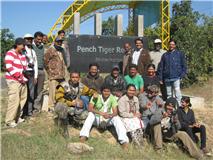
Field visits at Pench and Melghat Tiger reserve covered conservation biology and wildlife
population estimation by direct sighting method like transact and indirect method like pug
mark or sign identification method like census, data collection etc. A visit to the
resettled villages of Melghat tiger reserve was for the purpose of a socioeconomic survey
conducted there by the participants. Project writing during course was supervised by Dr.
Rady Rudran, who is currently working as a scientist emeritus at Smithsonian Institute at
Washington D.C. He was ably assisted by Kishor Rithe, president of Satpuda foundation, Dr.
Tidke Head of Botany department Amravati University and Dr. G.N. Vankhede Head of the
Zoology department Amravati.
Scat analysis practical also conducted there to study the food pattern of Big Cat family.
Another interesting project was the identification of spider species in Melghat region under
the guidance of Dr. G.N. Vankhede. Dr. Bivash Pandav from WII and adv. Ritwick Datta lawyer at Delhi Highcourt gave guest lectures. Dr. Bivash Pandav’s lecture was on camera trapping, and on terminology used by naturalists like pug mark, hoof mark, scat, dung,
pellets, dropping. Identification of individuals by using camera trap shots, was revealing.
Adv. Ritwik Datta spoke on wildlife Protection act, environmental law, PA management,
legislation law, schedule and clauses etc. Participants enjoyed watching Ndtv Greenies
Award 2010 with adv. Ritwik Datta” who is one of the winners of “Green Hero Award”.
In those 20 days, participants who came from diverse backgrounds went back with one
conviction-that we need to conserve the wildlife of this unique habitat.
|
Web Page
Dear IWC member,
Team IWC is always endeavoring to improve your web experience at
http://www.IndianWildlifeClub.com. Many of you have given valuable
feedback through our feedback button. We have now designed a more
detailed survey, which has five multiple choice questions. We request
you to read the various aspects of each of these five questions
carefully before clicking on the radio button which will take a note of
your response.
Completing the survey will take less than seven minutes. You can revise
your answers by going back till you hit the "Done" button. All
questions are compulsory.
Click on the link below to respond to our online survey
https://www.surveymonkey.com/s/2HHZM8W
A big Thank you to all who have responded to the survey on Environment Education. The survey has three pages, but some of you have attempted only the first page. But no worries, you can go back to the link and complete the survey.
|